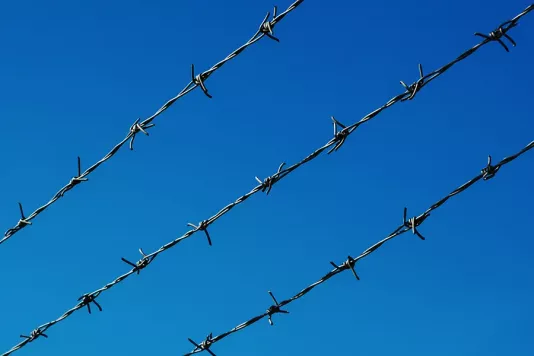Barbed Wire




| Main wire diameter D, mm | Barb wire diameter d, mm | Barb Spacing S, mm |
|---|---|---|
| 1.8 | 1.8 | 50; 75; 100; 125; 150 |
| 2.0 | 2.0 | 50; 75; 100; 125; 150 |
| 2.2 | 2.0 | 50; 75; 100; 125; 150 |
| 2.5 | 2.2 | 50; 75; 100; 125; 150 |
| 2.6 | 2.2 | 50; 75; 100; 125; 150 |
| 2.7 | 2.2 | 50; 75; 100; 125; 150 |
| 2.8 | 2.2 | 50; 75; 100; 125; 150 |
| 3.0 | 2.2 | 50; 75; 100; 125; 150 |
| Main wire diameter D1 & D2, mm | Barb wire diameter d, mm | Barb Spacing S, mm |
|---|---|---|
| 1.4 | 1.4 | 50; 75; 100; 125; 150 |
| 1.5 | 1.5 | 50; 75; 100; 125; 150 |
| 1.6 | 1.6 | 50; 75; 100; 125; 150 |
| 1.7 | 1.7 | 50; 75; 100; 125; 150 |
| 1.8 | 1.8 | 50; 75; 100; 125; 150 |
| 1.9 | 1.9 | 50; 75; 100; 125; 150 |
| 2.0 | 2.0 | 50; 75; 100; 125; 150 |
Purpose of the Barbed Wire
Barbed wire is used to create fences and hedges, as well as to be installed on fences and other structures. Barbed wire can be used in conjunction with a concertina or single coil barriers as a tension wire. The protective properties of barbed wire are high, but significantly lower than those of razor wire and razor wire barriers. For this reason, ordinary barbed wire is recommended for use in agriculture and other areas where safety requirements are not so high. Instead of barbed wire to protect the perimeter of critical facilities, it is recommended to razor wire, a spiral barrier, concertina, or another type of razor wire barrier.
Barbed Wire Construction
Barbed wire can have a different design. Several types of barbed wire are widespread - it can be single and double strand, double strand barbed wire may be ordinary and reverse twisted, traditional and double twisted. In the first case, the basis of barbed wire is one strand of steel wire, on which wire barbs are wound, in the second case, two strands of steel wire twisted together along the entire length serve as the basis. In ordinary twisted barbed wire, its strand wires are twisted in one direction; in reverse twisted wire, the strands twist direction changes between groups of wire barbs. Traditional and double twisted barbed wire differ in how the barbs are wound. In traditional twisted wire, the barbs are wound on one strand, while double twisted means that the barbed wire barbs are wound on both strands.
Barbed Wire Materials
Barbed wire is usually made from uncoated low carbon steel wire. For the manufacture of spikes, the same wire is used, only of a smaller diameter than the base. To increase the service life, zinc-coated wire is now widely used, in addition, it is possible to make barbed wire coated with a polymer that will protect against corrosion and give the barbed wire the desired color.
At What Price Can You Buy Barbed Wire?
Barbed wire can be bought at a price that depends on various factors. The price of barbed wire directly depends on the diameter of the warp, the number of warps, the distance between the spikes of the barbed wire, and also on the presence of a polymeric zinc coating on the barbed wire. In addition, if you buy barbed wire in small quantities, the price of barbed wire will be higher than the price at which you can buy it in bulk.


